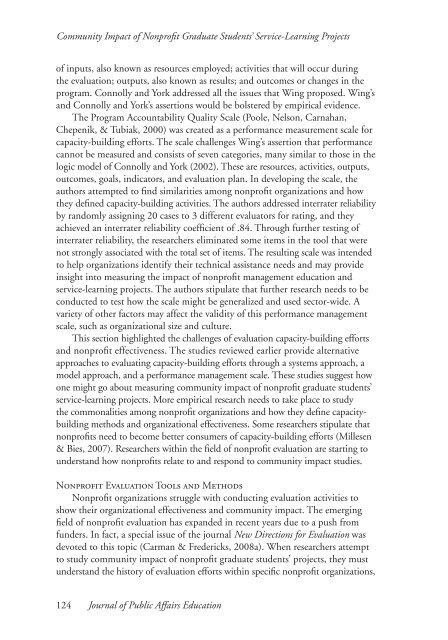Journal of Public Affairs Education
Create successful ePaper yourself
Turn your PDF publications into a flip-book with our unique Google optimized e-Paper software.
Community Impact <strong>of</strong> Nonpr<strong>of</strong>it Graduate Students’ Service-Learning Projects<br />
<strong>of</strong> inputs, also known as resources employed; activities that will occur during<br />
the evaluation; outputs, also known as results; and outcomes or changes in the<br />
program. Connolly and York addressed all the issues that Wing proposed. Wing’s<br />
and Connolly and York’s assertions would be bolstered by empirical evidence.<br />
The Program Accountability Quality Scale (Poole, Nelson, Carnahan,<br />
Chepenik, & Tubiak, 2000) was created as a performance measurement scale for<br />
capacity-building efforts. The scale challenges Wing’s assertion that performance<br />
cannot be measured and consists <strong>of</strong> seven categories, many similar to those in the<br />
logic model <strong>of</strong> Connolly and York (2002). These are resources, activities, outputs,<br />
outcomes, goals, indicators, and evaluation plan. In developing the scale, the<br />
authors attempted to find similarities among nonpr<strong>of</strong>it organizations and how<br />
they defined capacity-building activities. The authors addressed interrater reliability<br />
by randomly assigning 20 cases to 3 different evaluators for rating, and they<br />
achieved an interrater reliability coefficient <strong>of</strong> .84. Through further testing <strong>of</strong><br />
interrater reliability, the researchers eliminated some items in the tool that were<br />
not strongly associated with the total set <strong>of</strong> items. The resulting scale was intended<br />
to help organizations identify their technical assistance needs and may provide<br />
insight into measuring the impact <strong>of</strong> nonpr<strong>of</strong>it management education and<br />
service-learning projects. The authors stipulate that further research needs to be<br />
conducted to test how the scale might be generalized and used sector-wide. A<br />
variety <strong>of</strong> other factors may affect the validity <strong>of</strong> this performance management<br />
scale, such as organizational size and culture.<br />
This section highlighted the challenges <strong>of</strong> evaluation capacity-building efforts<br />
and nonpr<strong>of</strong>it effectiveness. The studies reviewed earlier provide alternative<br />
approaches to evaluating capacity-building efforts through a systems approach, a<br />
model approach, and a performance management scale. These studies suggest how<br />
one might go about measuring community impact <strong>of</strong> nonpr<strong>of</strong>it graduate students’<br />
service-learning projects. More empirical research needs to take place to study<br />
the commonalities among nonpr<strong>of</strong>it organizations and how they define capacitybuilding<br />
methods and organizational effectiveness. Some researchers stipulate that<br />
nonpr<strong>of</strong>its need to become better consumers <strong>of</strong> capacity-building efforts (Millesen<br />
& Bies, 2007). Researchers within the field <strong>of</strong> nonpr<strong>of</strong>it evaluation are starting to<br />
understand how nonpr<strong>of</strong>its relate to and respond to community impact studies.<br />
Nonpr<strong>of</strong>it Evaluation Tools and Methods<br />
Nonpr<strong>of</strong>it organizations struggle with conducting evaluation activities to<br />
show their organizational effectiveness and community impact. The emerging<br />
field <strong>of</strong> nonpr<strong>of</strong>it evaluation has expanded in recent years due to a push from<br />
funders. In fact, a special issue <strong>of</strong> the journal New Directions for Evaluation was<br />
devoted to this topic (Carman & Fredericks, 2008a). When researchers attempt<br />
to study community impact <strong>of</strong> nonpr<strong>of</strong>it graduate students’ projects, they must<br />
understand the history <strong>of</strong> evaluation efforts within specific nonpr<strong>of</strong>it organizations,<br />
124 <strong>Journal</strong> <strong>of</strong> <strong>Public</strong> <strong>Affairs</strong> <strong>Education</strong>



